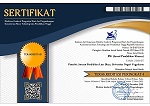IMPLEMENTATION OF RELIGIOUS VALUES ON INDIVIDUAL EDUCATION PROGRAM (IEP) BASED IN ISLAMIC ELEMENTARY SCHOOL
Elementary has emerged as an inclusive school in Indonesia recently. Eventhough some of them haven't shown the proper planning of inclusive learning, learning process, and optimal outcome learning for special needs students. Moreover if the learning process connected with religious value in Islamic elementary school. How the implementation of religious value can be involved in Individual Education Program (IEP) in elementary school? This paper discuss about Individual Education Program (IEP) based on religious value which conduct as a particular curriculum for special needs students (SNS). Investigation for specific purpose on this study headed to Islamic values development in SNS. The data collected from interviews, documents, and observation from Ar-Roihan Inclusive Islamic Elementary School Lawang that has been pointed as inclusive pilot project since 2016. Prior study has shown the benefit of inclusive school for disability children, but it's not focus on how Islamic values influence in their daily activities. Developed from data collected, the IEP program has reflected how the SNS used to and motivated to Islamic way in their daily activities, such as pray together, recite holy Qur'an, and respect for each other. Findings indicated that IEP which had given as individual treatment and lesson plan became an important thing for Islamic inclusive elementary school to reach their goal for disability students activities such as pray together, recite holy Quran, dan giving charity.
Downloads
Cortiella, C., & Horowitz, S. H. (2014). The state of learning disabilities: Facts, trends and emerging issues. New York: National Center for Learning Disabilities, 2–45.
Ekins, A. (2013). Special Education within the Context of an Inclusive School. In G. M. Ruairc, E. Ottesen, & R. Precey (Eds.), Leadership for Inclusive Education: Values, Vision and Voices (pp. 19–33). https://doi.org/10.1007/978-94-6209-134-4_3
Elvey, M. (2017). "You Don't Realise You Do That." In V. Plows & B. Whitburn (Eds.), Inclusive Education: Making Sense of Everyday Practice (pp. 159–174). https://doi.org/10.1007/978-94-6300-866-2_11
Halstead, J. M. (2007). Islamic values: A distinctive framework for moral education? Journal of Moral Education, 36(3), 283–296.
Hoover, J. J. (1987). Preparing special educators for mainstreaming: An emphasis upon curriculum. Teacher Education and Special Education, 10(2), 58–64. https://doi.org/10.1177/088840648701000202
Keputusan Dirjen Pendidikan Islam Nomor 3211 tahun 2016. (2016). Penetapan 22 Madrasah Inklusif. Dirjen Pendis.
Kramer, L. A., & Fask, F. J. (2017). A Star Is Born: Reaching One's True Potential. In L. A. Kramer & J. Freedman Fask (Eds.), Creative Collaborations through Inclusive Theatre and Community Based Learning: Students in Transition (pp. 127–163). https://doi.org/10.1057/978-1-137-59926-1_7
Kumar, G. (2018). The Ethics of Inclusion. In V. Kapur & S. Ghose (Eds.), Dynamic Learning Spaces in Education (pp. 319–333). https://doi.org/10.1007/978-981-10-8521-5_18
Mitchell, D. (2014). What Really Works in Special and Inclusive Education: Using evidence-based teaching strategies. Routledge.
Mitchell, D. R. (2004). Special Educational Needs and Inclusive Education: Assessment and teaching strategies. Taylor & Francis.
Noggle, A. K., & Stites, M. L. (2018). Inclusion and Preschoolers Who Are Typically Developing: The Lived Experience. Early Childhood Education Journal, 46(5), 511–522. https://doi.org/10.1007/s10643-017-0879-1
Pfeiffer, S. I., & Reddy, L. A. (2014). Inclusion Practices with Special Needs Students: Education, Training, and Application. Routledge.
Tandon, A. K. G. (2018). Implementing Inclusive in Schools. Notion Press.
Tomlinson, C. A., & McTighe, J. (2006). Integrating Differentiated Instruction & Understanding by Design: Connecting Content and Kids. ASCD.
United Nations Educational, Scientific, and Cultural Organization (UNESCO). (2003). Overcoming exclusion through inclusive approaches in education: A challenge & a vision. Conceptual paper. Retrieved from http://unesdoc.unesco.org/images/0013/001347/134785e.pdf.
Vickerman, P. (2007). Teaching Physical Education to Children with Special Educational Needs. Routledge.
Zhang, J.-W., Wong, L., Chan, T.-H., & Chiu, C.-S. (2014). Curriculum Adaptation in Special Schools for Students with Intellectual Disabilities (SID): A Case Study of Project Learning in One SID School in Hong Kong. Frontiers of Education in China, 9(2), 250–273. https://doi.org/10.1007/BF03397016















